QT interval

|
WikiDoc Resources for QT interval |
|
Articles |
|---|
|
Most recent articles on QT interval Most cited articles on QT interval |
|
Media |
|
Powerpoint slides on QT interval |
|
Evidence Based Medicine |
|
Clinical Trials |
|
Ongoing Trials on QT interval at Clinical Trials.gov Clinical Trials on QT interval at Google
|
|
Guidelines / Policies / Govt |
|
US National Guidelines Clearinghouse on QT interval
|
|
Books |
|
News |
|
Commentary |
|
Definitions |
|
Patient Resources / Community |
|
Patient resources on QT interval Discussion groups on QT interval Patient Handouts on QT interval Directions to Hospitals Treating QT interval Risk calculators and risk factors for QT interval
|
|
Healthcare Provider Resources |
|
Causes & Risk Factors for QT interval |
|
Continuing Medical Education (CME) |
|
International |
|
|
|
Business |
|
Experimental / Informatics |
Editor-In-Chief: C. Michael Gibson, M.S., M.D. [1]
Synonyms and keywords: QT; QTc; corrected QT interval; corrected QT
Overview
The QT interval is a measure of the time between the start of the Q wave and the end of the T wave in the heart's electrical cycle. The QT interval is a general measure of how long it takes for the heart to recharge or repolarize itself electrically. The QT interval is dependent on the heart rate such that the faster the heart rate, the shorter the QT interval. As a result, the QT interval must be adjusted for the heart rate for accurate interpretation. This adjustment is called the corrected QT interval or QTc. A lengthened QT interval is a biomarker for ventricular tachyarrhythmias such as torsades de pointes and is a risk factor for sudden cardiac death.
Historical Perspective
The standard clinical correction is to use Bazett's formula,[1] named after physiologist Henry Cuthbert Bazett, calculating the heartrate-corrected QT interval QTc.
The formula is as follows:
<math>QTc = \frac{QT}{\sqrt {RR} }</math>,
where QTc is the QT interval corrected for rate, and RR is the interval from the onset of one QRS complex to the onset of the next QRS complex, measured in seconds. However, this formula tends to not be accurate, and over-corrects at high heart rates and under-corrects at low heart rates.
In the same year, Fridericia [2] published an alternative adjustment:
<math>QT_F = \frac{QT}{RR^{1/3} } </math>.
There are several other methods, but a regression based approach is the most accurate according to the current knowledge. An example of the regression-based approach is that developed by Sagie et al.,[3] as follows:
<math>QT_S = QT + 0.154(1-RR)</math>.
Measurement
Normal values for the QT interval are between 0.30 and 0.44 (0.45 for women) seconds. QT interval can be measured by different methods such as the threshold method in which the end of the T wave is determined by the point at which the component of the T wave merges with the isoelectric baseline or the tangent method in which the end of the T wave is determined by the intersection of a line extrapolated from the isoelectric baseline and the tangent line which touches the terminal part of the T wave at the point of maximium downslope.[4]
Shown below is an example of normal QT interval.
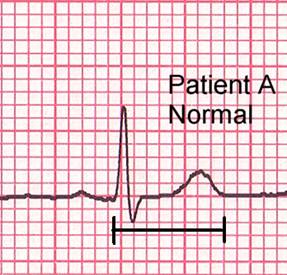
The QT interval is an important ECG parameter and the identification of ECGs with long QT syndrome is of clinical importance. Considering the required standards for precision, the measurement of QT interval is subjective.[5] This is because the end of the T wave is not always clearly defined and usually merges gradually with the baseline. QT interval in an ECG complex can be measured manually by different methods such as the threshold method, in which the end of the T wave is determined by the point at which the component of the T wave merges with the isoelectric baseline or the tangent method, in which the end of the T wave is determined by the intersection of a line extrapolated from the isoelectric baseline and the tangent line, which touches the terminal part of the T wave at the point of maximum downslope.[4]
With the increased availability of digital ECGs with simultaneous 12-channel recording, QT measurement may also be done by the 'superimposed median beat' method. In the superimposed median beat method, a median ECG complex is constructed for each of the 12 leads. The 12 median beats are superimposed on each other and the QT interval is measured either from the earliest onset of the Q wave to the latest offset of the T wave or from the point of maximum convergence for the Q wave onset to the T wave offset.[6]
Natural History, Complications and Prognosis
If the QT interval is abnormally prolonged or shortened, there is a risk of developing ventricular arrhythmias.
Genetic Causes
An abnormal prolonged QT interval could be due to Long QT syndrome, whereas an abnormal shortened QT interval could be due to Short QT syndrome.
Due to adverse drug reactions
Prolongation of the QT interval may be due to an adverse drug reaction.[7] Many drugs such as haloperidol[8] can prolong the QT interval.
Prolongation of the QT Interval:
- Represents an excess time required for completion of ventricular depolarization and repolarization.
- Abnormal when the QTc is > 0.44 seconds.
Shown below are examples of prolonged QY interval.
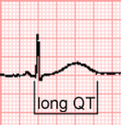
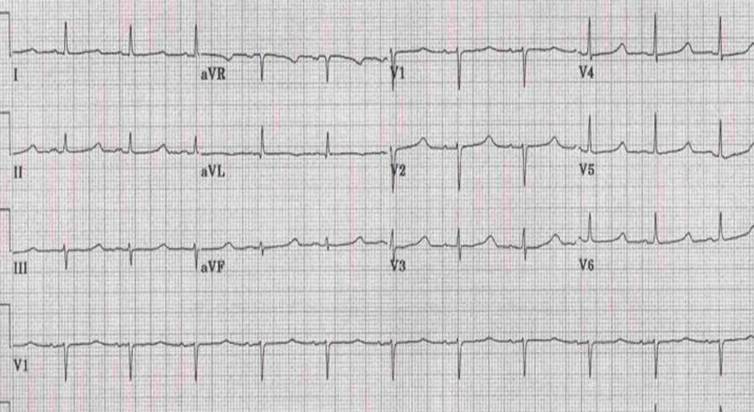
Shown below is an example of prolonged QT interval with bradycardia.
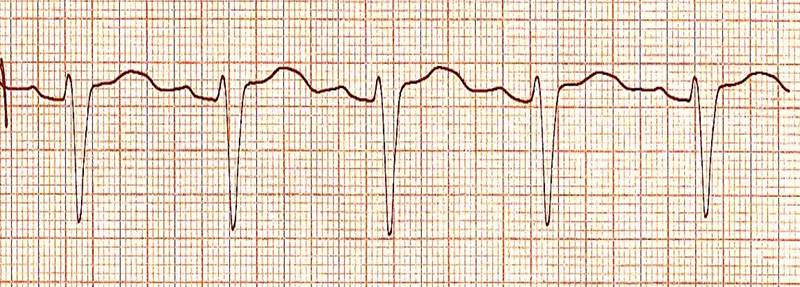
Shown below is an example of torsades de pointes
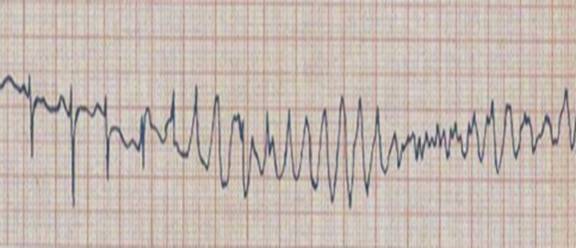
Drug Causes
Differential Diagnosis:
- Idiopathic long QT syndrome
- Jervell and Lange-Nielsen syndrome
- is associated with congenital deafness, syncope, and sudden death.
- autosomal recessive inheritance
- heterozygotes may be normal or have a slightly prolonged QT interval
- incidence among deaf mute children is .25%
- Romano-Ward syndrome
- clinically similar to the Jervell and Lange-Nielsen syndrome except the hearing is normal
- autosomal dominant
- heterozygotes and homozygotes persons may have similar symptoms
- Sporadic long QT syndrome
- females:males = 2:1
- 57% had a history of syncope
- there was a strong association between syncopal episodes and emotions, vigorous activities and loud noises.
- Pathogenesis
- imbalance between various components of the cardiac sympathetic innervation.
- Treatment to shorten the QT syndrome:
- left stellate ganglion block
- right stellate ganglion stimulation
- the administration of propranolol [9]
- Jervell and Lange-Nielsen syndrome
Short QT Interval
Shown below is an example of short QT interval.
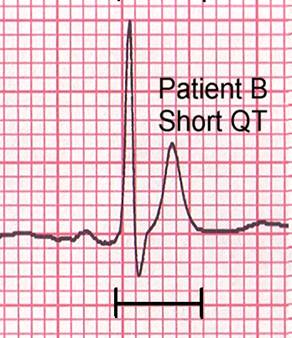
Causes
- Digoxin therapy
- Hypercalcemia
- Secondary (acquired) types of QT prolongation
- Coronary artery disease: Ischemia, infarction
- MVP, cardiomyopathy
- CNS disease, especially hemorrhage
- Autonomic nervous system dysfunction secondary to radical neck dissection, carotid endarterectomy, transabdominal truncal vagotomy.
- Metabolic disturbances. Electrolyte imbalance (such as hypocalcemia), liquid protein diet, intracoronary injection of contrast agents.
- Cardiac medications: Quinidine, PCA, disopyramide, encainide, flecainide, propafenone, amiodarone.
- Psychotropic drugs. Phenothiazines, tricyclic antidepressants.
- Miscellaneous. Severe bradycardia, high degree AV block, post Stokes-Adams attacks, hypothyroidism, hypothermia, pheochromocytoma, organophosphate poisoning.
References
- ↑ Bazett HC. (1920). "An analysis of the time-relations of electrocardiograms". Heart (7): 353–370.
- ↑ Fridericia LS (1920). "The duration of systole in the electrocardiogram of normal subjects and of patients with heart disease". Acta Medica Scandinavica (53): 469–486.
- ↑ Sagie A, Larson MG, Goldberg RJ, Bengston JR, Levy D (1992). "An improved method for adjusting the QT interval for heart rate (the Framingham Heart Study)". Am J Cardiol. 70 (7): 797–801.
- ↑ 4.0 4.1 Panicker GK, Karnad DR, Joshi R, Kothari S, Narula D, Lokhandwala Y (2006). "Comparison of QT measurement by tangent method and threshold method". Indian Heart J (58): 487–88.
- ↑ Panicker GK, Karnad DR, Joshi R, Shetty S, Vyas N, Kothari S, Narula D (2009). "Z-score for benchmarking reader competence in a central ECG laboratory". Ann Noninvasive Electrocardiol. 14 (14(1)): 19–25. doi:10.1111/j.1542-474X.2008.00269.x. PMID 19149789.
- ↑ Salvi V, Karnad DR, Panicker GK, Natekar M, Hingorani P, Kerkar V, Ramasamy A, de Vries M, Zumbrunnen T, Kothari S, Narula D (2011). "Comparison of 5 methods of QT interval measurements on electrocardiograms from a thorough QT/QTc study: effect on assay sensitivity and categorical outliers". J Electrocardiol. 44 (44(2)): 96–104. doi:10.1016/j.jelectrocard.2010.11.010. PMID 21238976.
- ↑ Andrew Leitch, Peter McGinness, and David Wallbridge, “Calculate the QT interval in patients taking drugs for dementia,” BMJ 335, no. 7619 (September 15, 2007): 557, http://www.bmj.com/cgi/content/short/335/7619/557 (accessed September 14, 2007) doi:10.1136/bmj.39020.710602.47
- ↑ "Information for Healthcare Professionals: Haloperidol (marketed as Haldol, Haldol Decanoate and Haldol Lactate)".
- ↑ Chou's Electrocardiography in Clinical Practice Third Edition, pp. 518-522.
Related Chapters
de:Elektrokardiogramm he:אלקטרוקרדיוגרם lb:Elektrokardiogramm nl:Elektrocardiogram sv:EKG